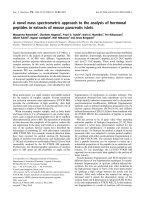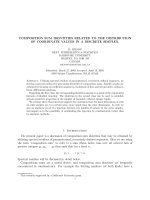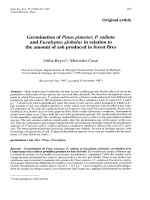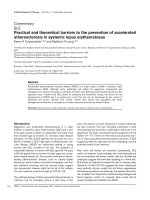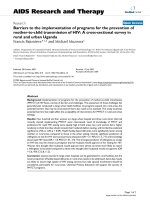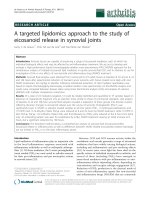Barriers to the adoption of blockchain technology in construction management a total interpretive structural modelling (tism) and dematel approach
Bạn đang xem bản rút gọn của tài liệu. Xem và tải ngay bản đầy đủ của tài liệu tại đây (2.07 MB, 131 trang )
VIETNAM NATIONAL UNIVERSITY HO CHI MINH CITY
HO CHI MINH CITY UNIVERSITY OF TECHNOLOGY
KHUC QUANG TRUNG
BARRIERS TO THE ADOPTION OF BLOCKCHAIN
TECHNOLOGY IN CONSTRUCTION MANAGEMENT: A
TOTAL INTERPRETIVE STRUCTURAL MODELLING
(TISM) AND DEMATEL APPROACH
Major: Construction Management
Major code: 8580302
MASTER’S THESIS
HO CHI MINH CITY, July 2023
THIS RESEARCH IS COMPLETED AT
HO CHI MINH CITY UNIVERSITY OF TECHNOLOGY – VNU–HCM
Supervisor: Assoc. Prof. Do Tien Sy
Supervisor: Dr. Nguyen Thanh Viet
Examiner 1: Dr. Huynh Nhat Minh
Examiner 2: Dr. Dang Ngoc Chau
This master‟s thesis is defended at HCM City University of Technology, VNUHCM City in room 409A4 – Building A4 - HCMUT Campus 1 on 19th July 2023.
Master‟s Thesis Committee:
1. Dr. Nguyen Anh Thu
- Chairman
2. Assoc. Prof. Tran Duc Hoc
- Member, Secretary
3. Dr. Huynh Nhat Minh
- Reviewer 1
4. Dr. Dang Ngoc Chau
- Reviewer 2
5. Dr. Chu Viet Cuong
- Member
Approval of the Chairman of the Master‟s Thesis Committee and Dean of Faculty
of Civil Engineering after the thesis being corrected.
CHAIRMAN OF THE
COUNCIL
HEAD OF FACULTY OF CIVIL
ENGINEERING
[i]
VIETNAM NATIONAL UNIVERSITY
HO CHI MINH CITY
HO CHI MINH CITY UNIVERSITY
OF TECHNOLOGY
SOCIALIST REPUBLIC OF VIETNAM
Independence – Freedom - Happiness
THE TASK SHEET OF MASTER’S THESIS
Full name: Khúc Quang Trung
Student code: 2170309
Date of birth: 14.04.1996
Place of birth: Dong Thap
Major: Construction Management
Major code: 8580302
I.
THESIS TOPIC
Barriers To The Adoption Of Blockchain Technology In Construction Management: A
Total Interpretive Structural Modelling (TISM) And DEMATEL Approach
TÊN ĐỀ TÀI
Rào Cản Đối Với Việc Áp Dụng Công Nghệ Blockchain Trong Quản Lý Xây Dựng:
Phương Pháp Tiếp Cận Mơ Hình TISM và DEMATEL
II. TASKS AND CONTENTS
-
Identify the primary barriers affecting blockchain adoption in Vietnam.
-
Determine the interactions and contextual relationships among these barriers.
-
Evaluate the intensity of these interrelationships.
-
Provide implications for managers/practitioners to overcome the identified
barriers.
[ii]
III. TASKS STARTING DATE: 06.02.2023
IV. TASKS ENDING DATE: 10.06.2023
V. INSTRUCTOR:
-
Assoc. Prof. Do Tien Sy
-
Dr. Nguyen Thanh Viet
Ho Chi Minh City, 07th, August 2023
INSTRUCTOR 1
(Full name and signature)
INSTRUCTOR
(Full name and signature)
Assoc. Prof. Do Tien Sy
Dr. Nguyen Thanh Viet
HEAD OF ACADEMIC
DEPARTMENT
(Full name and signature)
Dr. Le Hoai Long
DEAN OF FACULTY OF CIVIL
ENGINEERING
(Full name and signature)
Assoc. Prof. Le Anh Tuan
[iii]
ACKNOWLEDGEMENT
First, I acknowledge Ho Chi Minh City University of Technology (HCMUT),
VNU-HCM for supporting this study. Also, I would like to mention the support system
and consideration of Construction Management BK-IMP Lecturers and Facilitators,
who guided me in doing this thesis. I sincerely thank the lessons learned from the
lecturers at Yokohama National University, Japan.
In composing this master's thesis entitled "Barriers to the Adoption of Blockchain
Technology in Construction Management: A Total Interpretive Structural Modeling
(TISM) and DEMATEL Approach", I have been fortunate to receive a tremendous
amount of guidance, support, and inspiration.
Dr. Nguyen Thanh Viet and Assoc. Prof. Dr. Do Tien Sy, my devoted and
enthusiastic advisor, deserves my deepest gratitude. They guided me through the
academic research labyrinth by providing me with essential resources, methodologies,
and thesis guidance. Their enthusiasm and dedication have sparked a fire within me,
inspiring me to persevere and complete this thesis.
I would also like to salute my companions Son and Nhu, whose friendship, shared
humor, and mutual support have made the journey more enjoyable.
In addition, this research would not have been possible without the generous time
and effort of the twelve experts who participated in the four survey sessions and
substantially improved the quality of this work.
Lastly, but by no means least, my sincere gratitude goes to my beloved Vy. Her
invaluable advice on Blockchain technology, along with her unwavering support and
encouragement during my difficult times, has been invaluable.
[iv]
ABSTRACT
Blockchain technology (BTC) has the potential to revolutionize the efficacy, trust,
and procurement practices of numerous industries, including the construction sector.
Nonetheless, there is a dearth of research on the barriers preventing blockchain
adoption in the construction industry. This study seeks to identify the primary barriers
to blockchain technology adoption in the construction industry.
Through a review of the relevant literature, the major barriers to blockchain
adoption have been identified. The study employs TISM to investigate the
interrelationships between these barriers and DEMATEL to establish cause-and-effect
relationships.
Integrating the TISM and DEMATEL methodologies reveals that regulatory
uncertainty, data privacy/security concerns, limited knowledge and expertise, and
reliance on blockchain administrators are crucial adoption considerations. In addition,
issues with scalability, uncertain benefits, and a lack of collaboration are dependent on
other identified barriers. The DEMATEL analysis identifies seven cause barriers,
while the remaining barriers are regarded as significant contributors to the overall
adoption challenges.
This study contributes by providing decision-makers with a comprehensive
comprehension of significant barriers through an integrated approach and by
facilitating contextual connections through cause-and-effect analysis. In addition, it
provides a novel strategy for promoting the adoption and utilization of blockchain
technology in the construction industry.
Keywords: Blockchain; Adoption barriers; The AEC industry; TISM; DEMATEL.
[v]
TĨM TẮT
ơng nghệ blockchain (BTC) có tiềm năng cách mạng hóa hiệu quả, niềm tin và thực
hành mua sắm của nhiều ngành công nghiệp, bao gồm ngành xây dựng. Tuy nhiên,
hiện nay còn thiếu hụt các nghiên cứu về những rào cản ngăn chặn việc áp dụng
blockchain trong ngành xây dựng. Nghiên cứu này tìm kiếm để xác định các rào cản
chính cho việc áp dụng cơng nghệ blockchain trong ngành xây dựng.
Thông qua việc xem xét lại văn bản liên quan, các rào cản lớn đối với việc chấp
nhận blockchain đã được xác định. Nghiên cứu sử dụng TISM để điều tra mối quan hệ
tương hỗ giữa các rào cản này và DEMATEL để thiết lập mối quan hệ nguyên nhân và
kết quả.
Kết hợp phương pháp TISM và DEMATEL cho thấy rằng sự không chắc chắn về
quy định, những lo ngại về quyền riêng tư/an ninh dữ liệu, hạn chế kiến thức và
chuyên môn, và sự phụ thuộc vào quản trị viên blockchain là những yếu tố quan trọng
cần xem xét khi chấp nhận. Ngoài ra, vấn đề về khả năng mở rộng, lợi ích khơng rõ
ràng, và thiếu sự hợp tác phụ thuộc vào các rào cản khác đã được xác định. Phân tích
DEMATEL xác định ra bảy rào cản nguyên nhân, trong khi các rào cản còn lại được
coi là những đóng góp quan trọng cho những thách thức chung trong việc chấp nhận.
Nghiên cứu này góp phần bằng cách cung cấp cho người ra quyết định một sự hiểu
biết toàn diện về các rào cản quan trọng thơng qua một phương pháp tích hợp và bằng
cách tạo ra các mối liên hệ ngữ cảnh thông qua phân tích ngun nhân và kết quả.
Ngồi ra, nó cung cấp một chiến lược mới để thúc đẩy việc chấp nhận và sử dụng công
nghệ blockchain trong ngành xây dựng.
Keywords: Công nghệ Blockchain; rào cản; TISM; DEMATEL.
[vi]
AUTHOR’S COMMITMENT
The undersigned below:
Name
: Khuc Quang Trung
Student ID
: 2170309
Place of birth
: Dong Thap
Date of birth
: 14.04.1996
Address
: Resgreen Apartment, 7A Thoai Ngoc Hau Street,
Phu Trung Ward, Tan Phu district, Ho Chi Minh City.
Email:
:
Phone number
: (+84) 907 154 046
With the declaring that the master thesis entitled “Barriers to the adoption of
Blockchain technology in construction management: A Total Interpretive Structural
Modelling TISM and DMATEL approach” has been done by the author under the
instruction of supervisors. All works, ideas, and material that was gained from other
references have been cited accurately.
Ho Chi Minh City, August 2023
Author
Khúc Quang Trung
Master Thesis
[vii]
Khuc Quang Trung - 2170309
TABLE OF CONTENT
THE TASK SHEET OF MASTER’S THESIS ........................................................... i
ACKNOWLEDGEMENT .......................................................................................... iii
ABSTRACT ................................................................................................................. iv
TÓM TẮT ......................................................................................................................v
AUTHOR’S COMMITMENT ................................................................................... vi
TABLE OF CONTENT ............................................................................................. vii
LIST OF FIGURES .......................................................................................................x
LIST OF TABLES ....................................................................................................... xi
CHAPTER 1: INTRODUCTION ................................................................................1
1.1. Problem Statement ...............................................................................................1
1.2. Research Objective...............................................................................................3
1.3. Scope of Study .....................................................................................................3
CHAPTER 2: LITERATURE REVIEW ....................................................................5
2.1. Definitions of blockchain .....................................................................................5
2.2. Blockchain characteristic .....................................................................................5
2.3. Blockchain network .............................................................................................7
2.3.1. Private and Public Blockchain .....................................................................8
2.3.2. Consortium blockchain ...............................................................................10
2.4. Main Blockchain platform .................................................................................11
2.4.1. Ethereum .....................................................................................................11
2.4.2. Hyperledger Fabric ....................................................................................12
2.5. Blockchain technology in the AEC industry......................................................13
2.6. Barriers to the adoption of blockchain in the AEC industry ..............................16
2.7. Research gap ......................................................................................................21
Master Thesis
[viii]
Khuc Quang Trung - 2170309
CHAPTER 3: METHODOLOGY .............................................................................24
3.1. TISM model .......................................................................................................24
3.2. MICMAC model ................................................................................................27
3.3. DEMATEL model ..............................................................................................28
3.4. Delphi technique ................................................................................................30
3.5. Development of the integrated TISM-DEMATEL-MICMAC ..........................33
CHAPTER 4: RESEARCH RESULTS .....................................................................40
4.1. Data collection ...................................................................................................40
4.2. TISM analysis ....................................................................................................42
4.2.1. Step 1: Identifying and defining the barriers ..............................................42
4.2.2. Step 2: Defining contextual relationships...................................................47
4.2.3. Step 3: Binary interpretation of pair-wise comparisons ............................48
4.2.4. Step 4: Reachability matrix and a check of transitivity ..............................49
4.2.5. Step 5: Level partitions ...............................................................................53
4.2.6. Step 6: development of digraph ..................................................................54
4.2.7. Step 7: Interaction matrix and Interpretive matrix ....................................55
4.2.8. Step 8: TISM model.....................................................................................56
4.3. MICMAC analysis .............................................................................................63
4.4. DEMATEL analysis ...........................................................................................65
4.5. An integrated TISM – DEMATEL ....................................................................68
CHAPTER 5: DISCUSSION ......................................................................................71
5.1. TISM Analysis ...................................................................................................71
5.2. MICMAC model ................................................................................................74
5.3. DEMATEL analysis ...........................................................................................76
5.4. Driving/dependent barriers to TISM, MICMAC, and DEMATEL ...................78
Master Thesis
[ix]
Khuc Quang Trung - 2170309
CHAPTER 6: CONCLUSION AND RECOMMANDATION ...............................81
6.1. Conclusion ..........................................................................................................81
6.2. Recommendation................................................................................................81
6.2.1. The barrier of regulatory uncertainty (B3): ...............................................81
6.2.2. The barrier of data privacy/security (B2): .................................................82
6.2.3. The barrier of lack of knowledge and expertise (B11): ..............................83
6.2.4. The barrier of dependency on blockchain operators (B7) .........................84
6.3. Research implication ..........................................................................................87
6.3.1. Practical implication ..................................................................................87
6.3.2. Academic implication .................................................................................88
REFERENCES ............................................................................................................89
APPENDIX 1: QUESTIONAIRE SURVEY 1 .........................................................98
APPENDIX 2: QUESTIONAIRE SURVEY 2 .......................................................108
APPENDIX 3: QUESTIONAIRE SURVEY 3 .......................................................114
APPENDIX 4: QUESTIONAIRE SURVEY 4 .......................................................116
Master Thesis
[x]
Khuc Quang Trung - 2170309
LIST OF FIGURES
Figure 2.1. Blockchain process [35] [36] .....................................................................6
Figure 2.2. The skeleton of a private blockchain network [38]......................................9
Figure 2.3. The skeleton of a public blockchain network [38] .......................................9
Figure 2.4. The Skeleton of a consortium blockchain network [38] ............................11
Figure 4.1. TISM model – a simple version ..................................................................55
Figure 4.2. TISM model ................................................................................................62
Figure 4.3. MICMAC diagram .....................................................................................64
Figure 4.4. Cause Effect Diagram ................................................................................67
Figure 4.5. Integrated TISM-DEMATEL model ...........................................................70
Figure 6.1. An Introduction to Zero-knowledge Proof .................................................86
Master Thesis
[xi]
Khuc Quang Trung - 2170309
LIST OF TABLES
Table 2.1. Characteristics of previous studies ..............................................................18
Table 2.2. List of Barriers, descriptions, and references ..............................................20
Table 3.1. A comparison of DEMATEL with AHP/ANP/SEM [83] ..............................29
Table 3.2. Characteristics of Delphi Studies in CEM Research [87] ...........................31
Table 4.1. Experts’ background information ................................................................41
Table 4.2. Initial reachability matrix ............................................................................49
Table 4.3. Final reachability matrix .............................................................................49
Table 4.4. Elements providing transitivity ....................................................................50
Table 4.5. The interpretive logic knowledge base.........................................................51
Table 4.6. Levels partition of barriers to blockchain adoption ....................................54
Table 4.7. Interaction matrix.........................................................................................55
Table 4.8. Interpretive matrix .......................................................................................57
Table 4.9. Driving power and dependence on barriers ................................................63
Table 4.10. Initial average direct influence matrix A ...................................................65
Table 4.11. Normalized initial direct influence matrix N .............................................66
Table 4.12. Total relationship matrix T ........................................................................66
Table 4.13. The degree of direct and indirect influences ..............................................67
Table 4.14. Inner dependency matrix (α = 0.05) ..........................................................68
Table 5.1. Final results of TISM – MICMAC – DEMATEL model ...............................79
Table 6.1. The comparison among different suppliers ..................................................87
Master Thesis
[1]
Khuc Quang Trung - 2170309
CHAPTER 1: INTRODUCTION
1.1. Problem Statement
Blockchain technology (BCT) has emerged as a promising solution to revolutionize
various industries, including agriculture [1], insurance [2], supply chain management
[3], healthcare [4], and the AEC industry [5]. The potential of blockchain is recognized
by the World Economic Forum Espinel, et al. [6], which predicts it will be one of the
top computing mega-trends impacting the world in the coming decade. The
transformative potential of blockchain technology in the AEC industry has been
discussed by several scholars including Li, et al. [7] and Hunhevicz and Hall [8], Kiu,
et al. [9], who highlight its ability to provide transparency, immutability, and security.
As a result, the implementation of blockchain technology has the potential to
considerably improve the efficacy and dependability of numerous AEC industry
practices, including project management and construction supply chain optimization.
On the one hand, The AEC industry is one of the largest in the world, but in recent
decades it has been less productive than the other manufacturing sectors and faced
many challenges [10]. Firstly, the lack of efficient collaboration, information sharing,
and workflow management among stakeholders presents significant obstacles that
have a negative effect on efficiency and performance [9]. One illustration of these
challenges is found in the construction industry, where inadequate coordination and
collaboration can result in inefficiencies within the supply chain, as well as the need
for costly rework [11]. In 2018, these difficulties exacted a steep price on the US
construction industry, amounting to an estimated $31 billion in costs [12]. Secondly,
the progression of a project frequently involves the exchange of money and/or
information. Nevertheless, when a significant proportion of project activities (such as
prefabrication) occur off-site or overseas, issues such as the loss of management
control, inconsistent payment terms, and unstable cash-flow arrangements can arise.
These factors have led to an increase in disputes and disputes, as payments may be
delayed and concerns regarding quality fraud and the veracity of data within
construction business processes may arise [13]. Thirdly, the AEC industry has
experienced fragmentation and discontinuity as a result of the large number of
Master Thesis
[2]
Khuc Quang Trung - 2170309
stakeholders and the complexity of the design, manufacturing, storage, transportation,
and on-site assembly processes [14]. Consequently, there is a significant lack of an
accessible, dependable, transparent, and traceable information resource. As a result,
both clients and contractors struggle to verify and validate the veracity of information
pertaining to the various interactions among stakeholders, such as professional
qualifications, building material certifications, project deliverable timeline, and
quality. As a result, inefficiencies in construction project timelines, costs, and quality
may arise, leading to client dissatisfaction and potentially impacting the national
economy at large.
On the other hand, the construction industry faces several challenges, including
ineffective communication, delays, disputes, and errors. However, blockchain
technology offers a promising solution to these problems. By providing a decentralized
platform for recording and sharing information, blockchain enables real-time tracking
and monitoring of construction activities, creating a trusted and secure environment for
transactions and data exchange [9]. Smart contracts, a key feature of blockchain
technology, can automate and enforce the terms and conditions of construction
contracts, leading to fewer disputes and delays and ensuring timely payment and
delivery of projects [15].
Additionally, blockchain technology can create a digital identity for construction
materials, equipment, and personnel, which can improve the tracking and management
of the supply chain [16]. This is particularly useful in addressing issues related to
quality control and material traceability. Furthermore, blockchain can be utilized to
create a digital twin of buildings, which enables better monitoring and maintenance of
building systems and components, providing a comprehensive database for future
upgrades and renovations [17]. The integration of blockchain with the building
information model (BIM) can further enhance the efficiency and effectiveness of the
BIM working environment by improving the management and sharing of information
among project stakeholders [18, 19].
Regarding the adoption of this technology, it is difficult in order to integrate and
implement blockchain technology in the majority of businesses including the AEC
industry. The adoption of blockchain technology in the AEC sector involves several
Master Thesis
[3]
Khuc Quang Trung - 2170309
barriers that demand rapid attention. For instance, the connectivity between smart
contracts and complex projects [20], data privacy and storage [21] [13], platform
selection [22], the cost of adopting blockchain systems [13], and legal and regulatory
uncertainties [7]. Moreover, there may be several linkages between barriers [23].
Nonetheless, blockchain adoption barriers in the AEC sector have received little
consideration. In order to speed up the future acceptance and deployment of this
technology in the AEC sector, it is essential to understand these barriers and their
interrelationships. Consequently, this thesis investigates three specific research
questions:
- RQ1: What are the most significant barriers to blockchain adoption in the AEC
industry?
- RQ2: What are the interrelationships and contextual ties between the barriers?
- RQ3: What is the strength of these interdependencies?
1.2. Research Objective
This thesis seeks to investigate and assess the barriers and their interrelationships
associated with the adoption and utilization of blockchain technology in the AEC
industry, particularly Vietnam's AEC sector. The specific objectives of the thesis are as
follows: (1) identify and determine key adoption barriers through a literature review
and expert feedback; (2) model those barriers in order to illustrate their
interrelationships and hierarchical structure; and (3) assess the strength of causal
interrelationships among recognized constructs and classify them.
1.3. Scope of Study
This thesis aims to investigate the barriers hindering the adoption of blockchain
technology in Vietnam's AEC industry and analyze the interrelationships among these
barriers. Blockchain has the potential to revolutionize the AEC industry, but its
adoption has been slow due to various challenges. To provide a comprehensive
analysis, this study does not set a time limit on the publication date of the articles
considered. Relevant articles were obtained from various databases, including Science
Direct, SCOPUS, Web of Science, ASCE Library, Emerald, and Springer, using
keywords such as "Blockchain," "architecture," "engineering," "construction," or
Master Thesis
[4]
Khuc Quang Trung - 2170309
"project management." In addition to databases, credible journal articles, books, and
reports were consulted in order to compile an exhaustive list of barriers.
This research will target experts from reputable companies and academic
institutions within Vietnam's AEC industry in order to collect data. The designated
industry professionals will have a minimum of ten years of experience in a tactical
capacity within the AEC industry. The academic respondents will hail from reputable
management and engineering institutes or colleges with extensive blockchain
expertise. The data acquired from the experts will be analyzed to determine the
primary obstacles to blockchain adoption in Vietnam's AEC industry and to investigate
their interrelationships. Finally, recommendations for overcoming these obstacles and
promoting the implementation of blockchain technology in the AEC industry will be
provided.
Master Thesis
[5]
Khuc Quang Trung - 2170309
CHAPTER 2: LITERATURE REVIEW
2.1. Definitions of blockchain
Blockchain is generally defined as a distributed ledger technology that provides a
decentralized and immutable record of network participant transactions. Dounas and
Lombardi [24], describe blockchain as a database technology comprising a distributed ledger,
a consensus protocol, and cryptography. The technology was devised by Satoshi Nakamoto in
2008, and its most prominent application is in the Bitcoin cryptocurrency.
Hamma-adama, et al. [25] defines blockchain as a form of distributed ledger technology
(DLT) that records all executed and shared digital transactions and events among network
participants. Akinradewo, et al. [26] defines blockchain as a distributed ledger on a peer-topeer network that stores data on multiple devices without a central server. Li, et al. [7], a
blockchain is a form of expanding an inventory of documents called blocks that are
cryptographically linked using hashes.
According to Tyagi, et al. [27], blockchain is a decentralized network in which there is no
central organization that controls every transaction and every transaction is visible to every
node on the network. Yang, et al. [13] note that there are two types of blockchain networks:
public blockchain networks that can be accessed by the public through generic consensus
mechanisms, and consortium blockchain networks in which users must be pre-identified and
the mechanism for obtaining their consensus must be specified in advance. Abrishami and
Elghaish (2019) [28] note that blockchain is a permissioned digital ledger that enables secure,
transparent, and unchangeable financial transactions in the AEC industry.
2.2. Blockchain characteristic
The emergence of blockchain technology was motivated by the need for a financial system
that is transparent, decentralized, autonomous, and stable [29]. In 2008, Satoshi Nakamoto
proposed the concept that laid the foundation for Bitcoin [30]. Since then, blockchain has
been utilized in numerous applications [31].
Blockchain technology functions as a distributed public ledger that encrypts all digital
transactions and records them in chronological order [32]. Every new transaction resulted in
an updated and validated digital ledger, thereby creating an immutable record. Once network
Master Thesis
[6]
Khuc Quang Trung - 2170309
participants approve a new block, the consensus is added to the current chain, and the
transaction is carried out. Every block in the chain corresponds to an entry in the ledger
containing transaction data and a hash that links it to the block that came before it. If there is
no consensus, the new block is rejected [33]. Decentralization is a defining characteristic of
blockchain technology, as the network is managed by all chain participants without a central
authority or infrastructure [34]. This means that each participant has a copy of the ledger
stored locally.
Step 1: transaction intiation
X initiates transaction with Y
Step 2: Creation of new Block
Block is created online
representing the transaction
Step 3: Broadcast of Block to
network
Block is broadcasted to all members in
network to verify consensus
Step 4: Verification of Block
Approval and validation
of transaction
No consensus
Consensus received
for approval
Step 5: Block is added to existing
chain
Block is added permanently to existing
blockchain as a transparent record
Step 6: Execution of transaction
Transaction between X and Y is
executed
Figure 2.1. Blockchain process [35] [36]
Transaction Scrapped
Master Thesis
[7]
Step 1: transaction intiation
X initiates transaction with Y
Step 2: Creation of new Block
Block is created online
representing the transaction
Step 3: Broadcast of Block to
network
Block is broadcasted to all members in
network to verify consensus
Step 4: Verification of Block
Approval and validation
of transaction
Khuc Quang Trung - 2170309
No consensus
Transaction Scrapped
Consensus received
for approval
Step 5: Block is added to existing
chain
Block is added permanently to existing
blockchain as a transparent record
Step 6: Execution of transaction
Transaction between X and Y is
executed
Figure 2.1 depicts the sequential functioning of transactions on the blockchain, with 'X' and
'Y' representing the parties involved. 'X' initiates the transaction, whereas 'Y' is the recipient.
The transaction is subsequently shared and publicly validated across the entire decentralized
network, generating a new approval block. Once network participants approve a new block,
the consensus is added to the current chain, and the deal is carried out. Every block in the
chain is an entry in the ledger containing transaction data and a hash linking it to the block
that came before it. If no consensus is reached, the new block is rejected [33].
2.3. Blockchain network
As a type of Distributed Ledger Technology (DLT), a blockchain operates by digitizing
and decentralizing transactions. It serves as a database that documents and distributes digital
events to network participants [13]. Notably, blockchain transactions are organized into
blocks and have an immutable cryptographic signature. Each new block's cryptographic
signature is derived from the signature of the preceding block, producing a connected chain.
This design permits members who lack trust to interact in a peer-to-peer network without
relying on a central authority [29]. In this decentralized network, transactions are visible to all
nodes, allowing data to be accessed and verified throughout the blockchain network. Using
Master Thesis
[8]
Khuc Quang Trung - 2170309
any network-connected computer, users can verify the veracity and dependability of data by
examining data and tracing transaction history. For example, blockchain can facilitate the
creation of unique ownership certificates for land titles, enabling purchasers to access
property information and verify trading records without the risk of forgery [13]. The
immutability and tamper-proof nature of the data recorded on the blockchain is ensured by
the sequential addition of blocks, each of which contains a cryptographic hash of the
preceding block. Once added, records on a blockchain cannot be modified, concealed, or
falsified [33]. Moreover, due to the secure nature of the peer-to-peer network, all transactions
are stored in an immutable manner [33]. As each transaction is validated and recorded with a
timestamp [37], any blockchain user can easily trace past transactions by connecting to any
network node. In the literature, blockchain networks are classified based on a variety of
criteria, with management and permission levels functioning as the most prevalent
classification [37].
2.3.1. Private and Public Blockchain
Both private and public blockchain networks have decentralized structures and are used
without a trusted third party to record peer-to-peer transactions [13] without the need for a
trusted third party. However, they have distinct differences.
Private blockchains have a high transaction processing rate and a limited number of
authorized participants, allowing for a faster consensus and the processing of multiple
transactions per second when compared with public blockchain networks as illustrated in
Figure 2.2. Public blockchains, on the other hand, have a limited transaction processing rate
because the entire network must reach consensus on the transaction state, as with Bitcoin's
Proof-of-Work (PoW) consensus mechanism. Due to their append-only data processing,
which results in immutable data storage [13], public blockchains also pose privacy risks. In
public blockchains, all nodes must concur on any change, and mining a single block onto the
blockchain takes time. Moreover, all blocks are linked back to the genesis block to ensure the
integrity of the blockchain [38]. Private blockchains, on the other hand, prioritize data
privacy and only permit modifications when all nodes concur [39]. Public blockchains lack
control over user upload actions, preventing the reversal of sensitive data submissions [40].
Master Thesis
[9]
Khuc Quang Trung - 2170309
Figure 2.2. The skeleton of a private blockchain network [38]
Public blockchains benefit from an unlimited number of anonymous nodes and encrypted
communication. Each node possesses both public and private keys, removing the need to trust
network users. As depicted in Figure 2.3, all network members can access and read all
blockchain transactions, which is a significant strength given that these transactions can be
independently verified by the general public. Private blockchains, in contrast, restrict network
access to verified parties for transaction verification. With increased decentralization and
more nodes, public blockchains present obstacles for malicious actors attempting to
manipulate the network. In contrast, private blockchains, which contain fewer nodes, are
more susceptible to control by malicious actors, thereby increasing the likelihood of hijacking
and data manipulation. Consequently, public blockchains are regarded as more secure.
Moreover, public blockchains necessitate no infrastructure costs, whereas private blockchains
necessitate substantial adoption and operational costs [40].
Figure 2.3. The skeleton of a public blockchain network [38]
Master Thesis
[10]
Khuc Quang Trung - 2170309
Federated blockchains incorporate public and private blockchain characteristics [38]. In
contrast to the strict public/private dichotomy, federated blockchains appoint a named leader
to verify transaction processes, resulting in a partially decentralized blockchain system [13].
This composite network paradigm provides a balance between low-trust (public blockchains)
and high-trust (private blockchains) entity approaches [41].
2.3.2. Consortium blockchain
Consortium blockchains, also referred to as federated blockchains, are semi-private
blockchain solutions with no single owner. As depicted in Figure 9, these blockchain
platforms distribute privileged nodes throughout the network. Consortium blockchains share
a number of advantages with private blockchains, including privacy, efficiency, scalability,
and performance, but they are administered by a group as opposed to a single entity [42].
Governance plays a crucial role in consortium blockchains as a result.
Similarly, to private blockchains, consortium blockchains can restrict participants based on
differing levels of access to the ledger's information and can even provide distinct data sets.
Certain groups of organizations can have exclusive communication channels and data
accessible only to their respective associations. For instance, certain users may be permitted
to examine all or a subset of ledger transactions and pre-approved nodes.
More so than in the past, enterprises operate across multiple networks today. The financial
industry devised and implemented Corda R3, a widely used consortium blockchain network.
The construction industry frequently operates in consortia or partnerships, and consortium
blockchain solutions can promote greater collaboration by enhancing trust and transparency
within these partnerships. Consortium blockchain has privileged permissioned nodes across
the network as illustrated in Figure 2.4.
Master Thesis
[11]
Khuc Quang Trung - 2170309
Figure 2.4. The Skeleton of a consortium blockchain network [38]
2.4. Main Blockchain platform
Ethereum, Hyperledger Fabric, and Corda by R3 are three of the primary blockchain
platforms. Ethereum and Hyperledger Fabric are adaptable across all sectors, whereas R3's
Corda is primarily used in the financial services sector [13]. In this study, Ethereum and the
Hyperledger Fabric as an entire are evaluated and adopted.
2.4.1. Ethereum
Blockchain 1.0, the fundamental technology of Bitcoin, was the first implementation of
Nakamoto's [43] concept of blockchain technology. This initial implementation of blockchain
was utilized predominantly for cryptocurrencies. 2015 saw the introduction of Blockchain
2.0, which brought the concept of smart contracts to the forefront of the industry. Ethereum,
the second public blockchain platform, was created as a consequence of this evolution [10].
Ethereum, proposed by Buterin [44], is a blockchain-based distributed computation
platform that facilitates the decentralization of transactions and markets, thereby expanding
the application possibilities of blockchain technology. It is a blockchain-based platform that
facilitates both public and private transactions. Inspired by Bitcoin, Ethereum uses a proof-ofstake (PoS) consensus algorithm, which is a successor and more efficient model than the
proof-of-work (PoW) model [45]. PoW, the underlying technology for the vast majority of
cryptocurrencies, employs game theory and cryptographic algorithms [46]. To randomly
select the victor, PoS is based on the proportion of stakes held by each participant.
Master Thesis
[12]
Khuc Quang Trung - 2170309
Ethereum is a multipurpose blockchain platform that enables users to construct
cryptocurrency-related applications and implement smart contracts. It distinguishes between
two categories of accounts: third-party accounts and contract accounts. Individuals possess
Ethereum-capable identities that are externally managed by a private key. By invoking
contract functions, such accounts may initiate transactions and interact with external
accounts. In contrast, contract accounts are governed by contract code and activated by
communications from other contract accounts or externally owned accounts.
Solidity, a popular scripting language, is commonly used for developing contract account
protocols. These protocols are then compiled into a stack-based programming language for
contract account execution [46].
2.4.2. Hyperledger Fabric
-
Hyperledger Fabric is a compilation of blockchain frameworks and tools [47] that
was initiated by the Linux Foundation at the beginning of 2016. Hyperledger is a
consortium composed of IBM, the Linux Foundation, and other organizations that
seek to encourage the creation of blockchain-based applications across industries
[35]. Hyperledger Fabric, a private blockchain platform that is modular and
permission, is regarded as one of the most developed blockchain platforms to date.
It is the first of its kind to facilitate smart contract execution in multiple generalpurpose languages for programming, including Node.js, Java, and Go [47].
-
The execute-order-validate architecture [13] of Hyperledger Fabric is one of its
distinguishing features that sets it apart from other platforms. The transaction flow
of this platform comprises transaction execution, prioritization, and validation.
Unlike public blockchains, each node in Hyperledger Fabric has a unique identity
and can perform one of the following functions [47]:
-
Clients: They propose and submit transactions for ordering.
-
Peers: These individuals execute transaction proposals, validate transactions, and
maintain blockchains.
-
Orderers (Ordering Service Nodes): These nodes aggregate client transactions and
determine the order of all transactions.
In addition to these nodes, Hyperledger Fabric includes the following design components:

